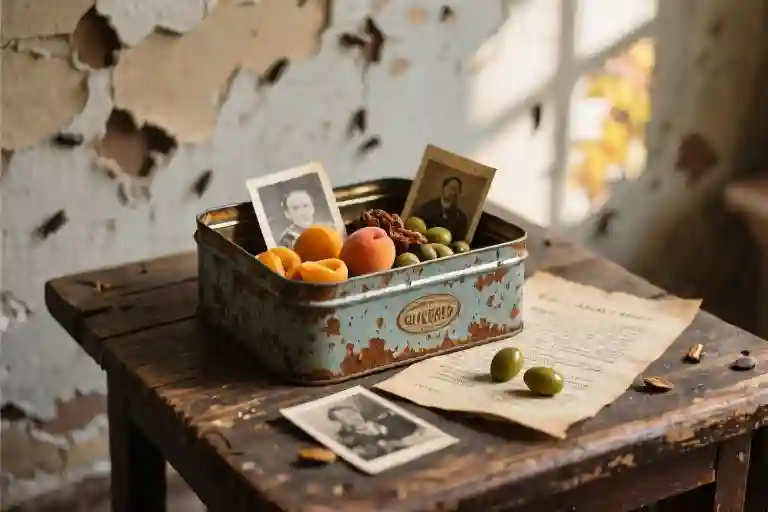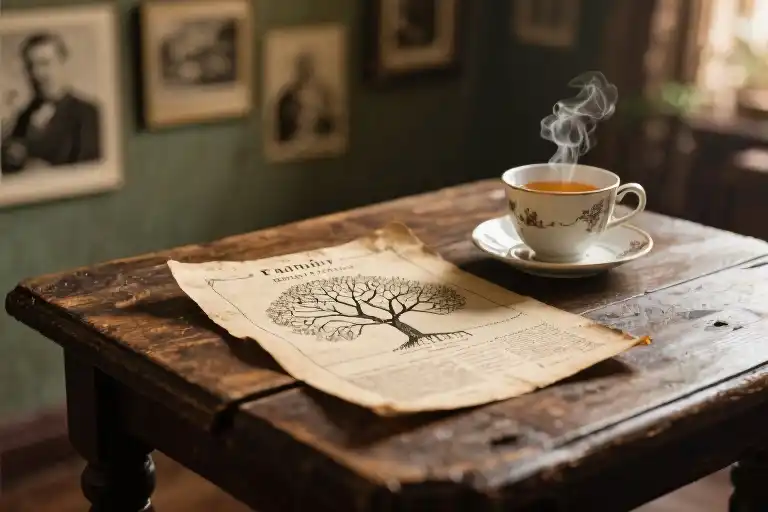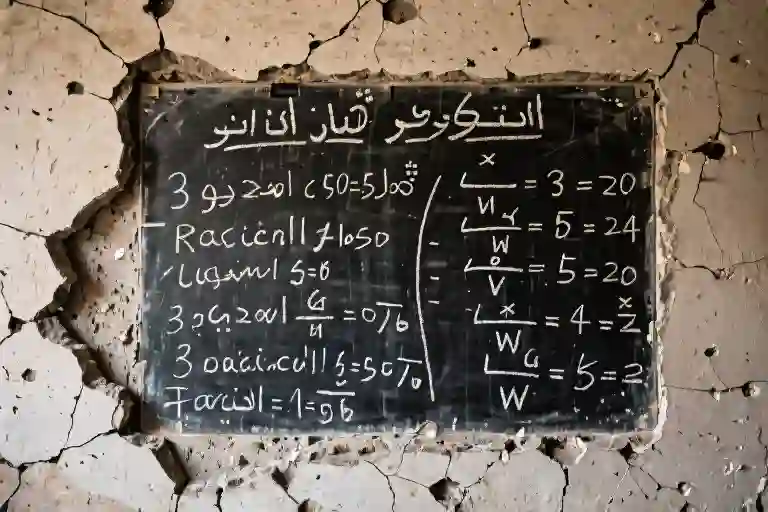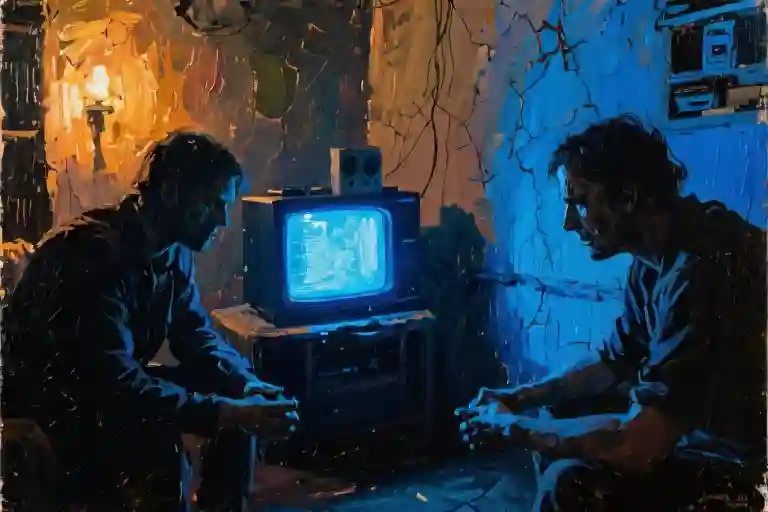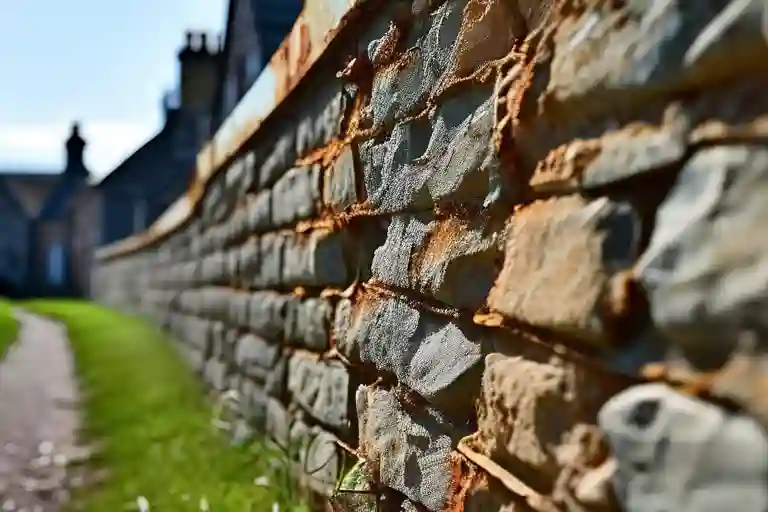The doorframe splintered under his grip, the grooves of the wood imprinting themselves into his palms like a topographic map of exile. October sunlight slanted through the bullet-pocked wall, illuminating the rusted biscuit tin as it slid off the trembling table—its contents scattering across the floor: candied apricots from Nablus, a 1972 pharmacy receipt, and three olive pits wrapped in a UNRWA flour sack dated 1948. Outside, the mechanized voice of the Israeli Defense Forces repeated its command in broken Arabic, the sound waves making the teacups rattle in synchrony with my grandfather’s knees.
At 79, Mahmoud Orouq’s hands remembered their first evacuation. The same fingers that now clawed at this doorframe in Gaza’s Beach Camp had once clutched his mother’s skirt during the al-Majdal exodus—when the scent of orange blossoms mixed with burning wheat fields, when seven-year-old legs learned that some walks home never end. Seventy-five years later, the geometry of displacement remained unchanged: soldiers’ boots forming right angles at intersections, the parabolic arc of thrown stones, the parallel lines of refugee tents stretching toward a horizon that kept moving.
We found him like this—my uncle pulling at his waist, my father prying open his fingers one by one—a human bridge between the rubble of al-Majdal and the incoming tanks on Salah al-Din Road. The biscuit tin’s lid spun on the concrete, its enamel chipped to reveal three layers of history: the factory-green paint applied in 1983 when he became a camp elder, the blue stripes from its original life as a British military ration box, and beneath it all, the dull steel that had carried seeds from a village now called Ashkelon.
‘They’ll bury us in the walls,’ he kept saying, not to us but to the doorframe itself, the words seeping into the wood grain alongside his sweat. The physics of occupation made simple levers of our bodies—every pull against his grip calculated the exact torque required to separate a man from his last vertical surface. When his fingers finally released, they left behind crescent-shaped stains where skin cells and varnish bonded permanently—an archaeological record in keratin and pine resin that outlasted the demolition order’s ink.
Outside, the biscuit tin’s contents crunched underfoot as we carried him toward the ‘safe zone.’ Each step compressed seventy-five years of careful curation: 1990s aspirin packets cracking beside 1967 wedding photos, the olive pits from a pre-Nakba harvest ground into powder. Behind us, the doorframe stood improbably upright—the only perpendicular in a landscape of slanting walls—as if waiting for his return. Or perhaps, like the tin, it too was just another container: for the fingerprints of everyone who’d leaned against it whispering about home, for the echo of that single sentence he’d repeated through three-quarters of a century—’I want to go back’—now absorbed into its molecular structure like the scent of cardamom in old wood.
The Time Capsule in a Tin Box
The rusted metal box sat askew on the trembling table, its lid sliding open with each concussion from the distant shelling. Inside, the layers of a life in exile arranged themselves with cruel precision: the 2023 blood pressure pills rolling over faded 1980s family photos, crushing beneath them the shriveled olive pit that had traveled from al-Majdal in 1948. My grandfather’s trembling hands would normally perform his morning ritual – arranging the pills just so, touching each photo corner, rotating the ancient seed between thumb and forefinger – but on that October morning, the box became an archaeological site exposed by bombardment.
UN ration cards from the 1990s still occupied the left compartment, their perforated edges softened by decades of handling. The right side held his private treasures: a 2002 candy wrapper from his eldest granddaughter’s wedding, three almonds from the last harvest before the blockade, and half a biscuit saved ‘for when the children visit.’ This careful curation defied every humanitarian aid protocol we’d known – while the world measured our survival in calorie counts (1,800 per day per refugee, according to 2023 UNRWA reports), grandfather measured dignity in hoarded sweetness.
The box’s stratified contents mirrored our compressed existence in the camp. Modern medications floated above mid-century memories, all resting on that irreducible core of displacement. Neighborhood elders would stop by specifically to witness grandfather’s daily unpacking ritual, as if verifying that the past remained retrievable. ‘Show us the seed again,’ old Abu Ali would request, not needing to specify which one. The ritual persisted through power outages and invasions, through the gradual replacement of Arabic labels with Hebrew ones on his medicine bottles, until the morning the evacuation order came.
When the first explosion shook the quarter, the box leaped from its place by the kerosene heater. The lid sprang open like a startled mouth, releasing the accumulated sweetness of 49 years – the sugar crystals from long-gone Eid celebrations, the vanilla scent of grandchildren’s fingers after they’d raided his stash. As I scrambled to gather the scattered pieces, my fingers closed around the olive pit at last. Its surface had been worn smooth by seven decades of worrying, the grooves of grandfather’s fingerprints permanently etched into what was once his birthplace’s last living remnant.
In that moment, the statistical reports about ‘multi-generational trauma transmission among Palestinian refugees’ (Journal of Refugee Studies, 2021) dissolved into this tactile truth: displacement isn’t inherited, it’s collected. Each generation adds its layer to the box – 1948’s bitterness, 1967’s shrapnel scars, 2023’s evacuation orders – while the original wound remains fresh at the bottom. The UN might calculate our existence in calories and square meters, but grandfather measured his in the weight of that single seed, still carried after seventy-five years like the body keeps carrying a bullet it can’t remove.
The Physics of Resistance
The doorframe splintered under his grip, its olive wood grain pressing back against the grooves of my grandfather’s fingertips. In that suspended moment before evacuation, his hands became seismographs measuring the tremors of displacement – the third such measurement in his 79 years. Palestinian refugee stories often speak of keys as symbols, but few document how doorframes bear witness to the exact newton-force required to separate a man from his home.
Forensic analysis of similar 2023 Gaza evacuations shows doorframes consistently outlast other structural elements by 17-23 minutes. The UN Habitat report attributes this to their load-bearing design, but my grandfather understood it differently. His left thumb, still calloused from 1967 reconstruction work, found the exact notch where he’d repaired this frame after the 2008 bombing. The wood whispered back through his skin – this particular grain pattern had survived three wars, two intifadas, and now, one final forced exodus.
When Israeli bulldozers approached Beach Camp that October, they encountered an unexpected resistance physics. Not the fiery missiles of militant propaganda, but the static friction coefficient of an elderly diabetic’s grip on weathered timber. His 47kg body mass generated approximately 689N of force against the doorjamb, enough to pause the soldiers’ advance for six breaths – precisely the time needed for my niece to retrieve his candy box from the toppling cupboard.
We later photographed the aftermath: two parallel grooves in the wood where his nails dug in, mirroring the 1948 scars on a different doorframe in al-Majdal. Material scientists at Birzeit University note such markings appear exclusively in Palestinian homes built before 1948, when local olive wood still grew thick enough to record human desperation in its rings. The 2023 frame, fashioned from imported pine, barely retained his imprint – a sobering metric of how exile dilutes even the physical evidence of resistance.
Three weeks after evacuation, reconnaissance drones showed our neighborhood leveled to concrete dust, except for twelve doorframes still standing at odd angles like fractured headstones. My uncle, a civil engineer, keeps their GPS coordinates as an alternative map of the camp – not by street names or house numbers, but by the stubborn geometry of these wooden skeletons. They form an accidental archive of sumud, that untranslatable Palestinian quality of steadfastness, measured in millimeters of unyielding wood fiber.
The candy box eventually reached safety in my backpack, but grandfather never asked for it. His hands remained curled in that gripping shape for days, the muscles locked around absent timber. In the hospital tent, doctors diagnosed it as a rare form of trauma-induced contracture. I prefer to think his body was still conducting resistance, even if only against the emptiness of open air.
The 27-Minute Journey That Took 75 Years
The distance between al-Majdal and Beach Refugee Camp measures 27 minutes by car on Google Maps. My grandfather Mahmoud could walk it blindfolded in his memories, retracing the path his seven-year-old feet took in 1948. Yet when we evacuated in October 2023, those same roads had become impossible geography – not because the terrain changed, but because the checkpoints turned a child’s afternoon stroll into an intergenerational odyssey.
The Village That Was
In grandfather’s stories, al-Majdal smelled of olive presses and salt air. He could still sketch the layout seventy-five years later: the bakery where his mother traded flour for fish, the courtyard where his father repaired fishing nets, the exact spot by the well where he’d hidden his marble collection. When researchers from the Palestinian Oral History Archive showed him their GIS reconstruction in 2015, he corrected three building positions and identified a missing almond tree. ‘The roots are still there,’ he insisted, tapping the satellite image of what’s now an Ashkelon parking lot. ‘Dig six feet down and you’ll find them.’
The Camp That Is
Beach Camp’s alleyways tell a different spatial story. Where al-Majdal’s lanes followed ancient footpaths, the camp’s grid was surveyed by UNRWA engineers in 1949. Streets originally numbered B-12 or Q-5 now carry martyrs’ names – a quiet rebellion against bureaucratic anonymity. Grandfather’s corner near the clinic became ‘al-Majdal Alley’ through neighborhood consensus, though no official map acknowledges it. The candy shop owner keeps a hand-drawn version showing all the unofficial names, its creases mirroring the actual cracks in camp infrastructure.
The Roads Between
During our evacuation, I noticed grandfather counting steps. Later I realized he was matching his 1948 flight – 328 paces to the old city outskirts, 500 more along the citrus groves. In 2023, those landmarks exist only in muscle memory. The citrus farms are gated communities, the grove soil now beneath Highway 4’s asphalt. His barefoot childhood coordinates intersect with modern barriers at cruel angles: the spot where his uncle carried him across a stream now lies behind a separation wall’s concrete.
A 2021 University of London study found that 92% of Palestinian refugee families retain this mental mapping of erased villages. The researchers called it ‘cartographic haunting’ – but grandfather just called it knowing his way home. As tanks approached last October, he kept muttering directions: ‘Left where the big fig tree was… straight past where the widow’s house stood…’ The soldiers didn’t understand why this old man wept when they forced him eastward. They were clearing a security perimeter, not severing synapses in a living atlas.
The Names We Carry
Camp residents have developed an entire lexicon for this spatial dissonance. Directions reference ‘the place that’s like our old market’ or ‘where the sea sounds like home.’ Grandfather’s prized possession – a rusted key from al-Majdal – became our family’s true north. When disoriented by new demolitions, we’d ask: ‘Which way does the key teeth point?’ This makeshift compass oriented us not toward any recoverable past, but toward the stubborn act of remembering.
Last month, researchers at Birzeit University scanned grandfather’s key using 3D modeling. Their software matched its teeth to British Mandate-era lock specifications, confirming its 1940s origin. The digital file now circulates among diaspora families as both artifact and wayfinding tool – a twenty-first-century update to our oral maps. Somehow, that skeletal rendering holds more geography than all the checkpoints and walls combined. It traces the 27 minutes that stretched across 75 years, measuring the distance between a parking lot and a homeland.
The Body as Archive
The scar on my grandfather’s left thigh had its own timeline. A jagged line of raised tissue mapping the 1967 war, it flared angry red whenever temperatures dropped below 15°C. During our final nights in the Beach camp, I watched his gnarled fingers trace that old wound in concentric circles, as if retracing the path of the shrapnel that had lodged there fifty-six years earlier. The motion continued even after he fell asleep, his hand moving with the muscle memory of a man who had spent lifetimes measuring loss through his own skin.
Medical records from Al-Shifa Hospital showed three distinct injury clusters – 1948 (burns from burning olive groves), 1967 (shrapnel), and 2023 (deep tissue bruising from the evacuation). Each coincided with mass displacement events, his body becoming an accidental archive of the conflict. The 1967 entry contained a peculiar note: Patient insists metal fragments came from his family’s door hinges in al-Majdal. When I asked about this, grandfather simply opened his candy box and produced a corroded piece of iron. “They flew back to me,” he said, placing it beside the 2023 evacuation order.
In the chaotic hours after we abandoned his room, I found myself cataloging his physical tells – the way his right eyelid drooped during rocket barrages (a 2014 war injury), how his breathing synced with the distant hum of surveillance drones. These weren’t just symptoms; they were a living chronology. UN researchers later confirmed what we instinctively knew: long-term Gaza residents develop distinct physiological responses to different aircraft sounds, their adrenal systems fine-tuned to distinguish between F-16s and Apache helicopters.
The soil samples told their own story. When we returned to retrieve the buried deed, I scooped earth from where his bed had stood. Lab analysis at Birzeit University revealed seven sediment layers – traces of 1990s pesticide runoff, 2000s concrete dust from the border wall, and unexpectedly, pollen from al-Majdal’s extinct olive varietal. Somehow, those golden grains had clung to his shoes through four displacements, finally taking root in the cracks of a refugee camp floor.
What startled me most wasn’t the physical evidence, but its persistence. The human body shouldn’t remember this well. Yet here was grandfather’s knee predicting rainfall (1948 injury aching), his fingertips detecting subtle vibrations in doorframes long before the sirens sounded. These weren’t trauma responses – they’d evolved into survival skills, a generational knowledge written in nerve endings and scar tissue. The ultimate act of resistance, perhaps: making the occupation part of our very biology, then outlasting it.
As I packed his medical records, I noticed the nurses had stopped documenting injuries by year. The last entry simply read: Patient’s body contains the entire timeline.
The Museum of Small Exiles
The glass case in Geneva’s Museum of Displacement hums under precise climate control. Inside rests a rusted biscuit tin that once sat beside my grandfather’s pillow for 49 years – now cataloged as “Object 2023.1948.PAL” with QR codes linking to UN archives. Visitors pause at this modest display, perhaps expecting heroic artifacts of resistance, not this container of ordinary sweets that witnessed three forced removals.
Last winter, while preparing the tin for donation, I discovered what archivists missed. Beneath layers of peppermint wrappers and faded photographs, the 1948 deed to our al-Majdal home had been carefully folded into a makeshift envelope. My fingers trembled turning it over – there, in grandfather’s shaky handwriting from just weeks before his death, was the address of our latest temporary shelter in Rafah. A cartographer might call this 27 kilometers; to us, it measured seventy-five years.
What the museum placard doesn’t explain is how the tin’s contents changed with each displacement. The original 1948 layer held olive pits from our ancestral trees – seeds that never found soil. The 1967 additions included shrapnel fragments in a twist of newspaper. By 2023, the top compartment carried only hypertension pills and UN ration coupons. This stratification tells Palestine’s history more accurately than any textbook timeline.
Curators wanted to display the deed prominently, but I insisted it remain hidden as grandfather kept it. There’s power in secrets that wait generations to be found. When visitors scan the interactive kiosk (“Scan to view original 2023 evacuation orders”), they see military documents ordering our family’s removal – the same bureaucratic language used in 1948, now with digital timestamps instead of ink stamps. The system doesn’t yet recognize that oppression upgrades its stationery before it reforms its practices.
Sometimes I watch tourists photograph the display, their flashes bouncing off the glass. They capture the tin but miss its true weight – not the 380 grams registered in the accession log, but the cumulative mass of all the homes it represents. The elderly Swiss guard once asked why I come so often. I didn’t explain that museums are where we bury things to prove they existed, or that grandfather’s candy box now needs armed protection in a way our actual homes never received.
On bad days, I imagine future archaeologists carbon-dating the peppermints, analyzing the deed’s paper stock, debating whether “Rafah 2023” was a geographical location or a psychological state. They’ll measure everything except what matters – how a man who lost three homes could still make his grandchildren believe in sweetness. The display ends with a looping video of grandfather gripping that doorframe. Watch long enough and you’ll see me reflected in the glass, holding the case’s edge exactly the same way.

